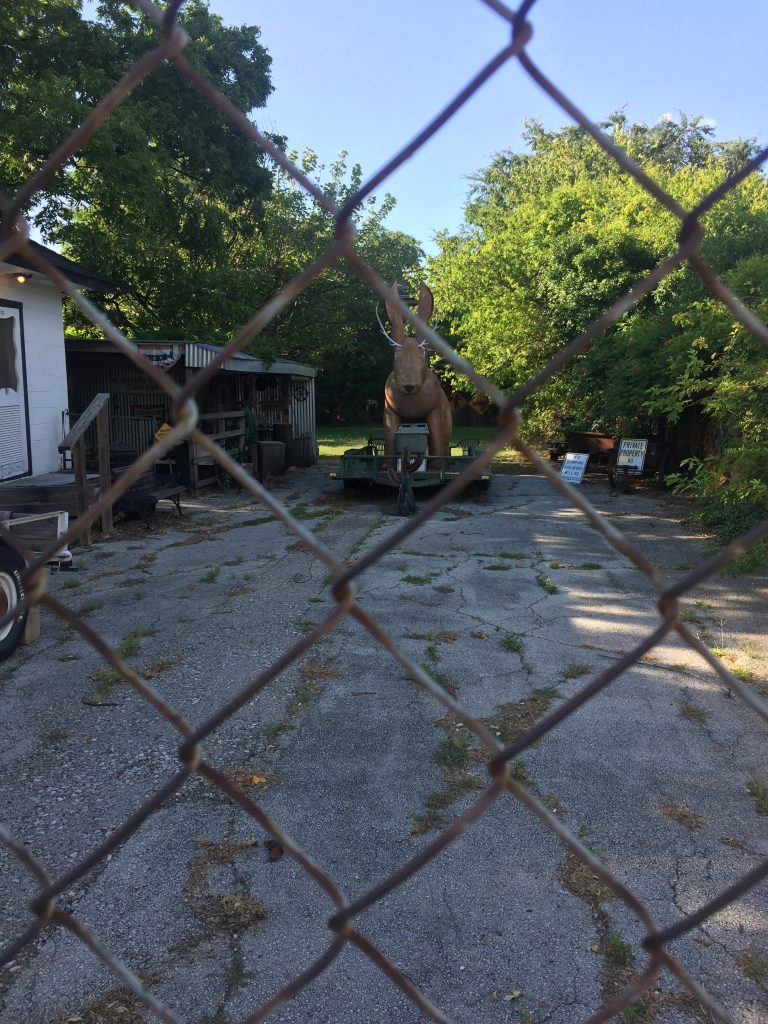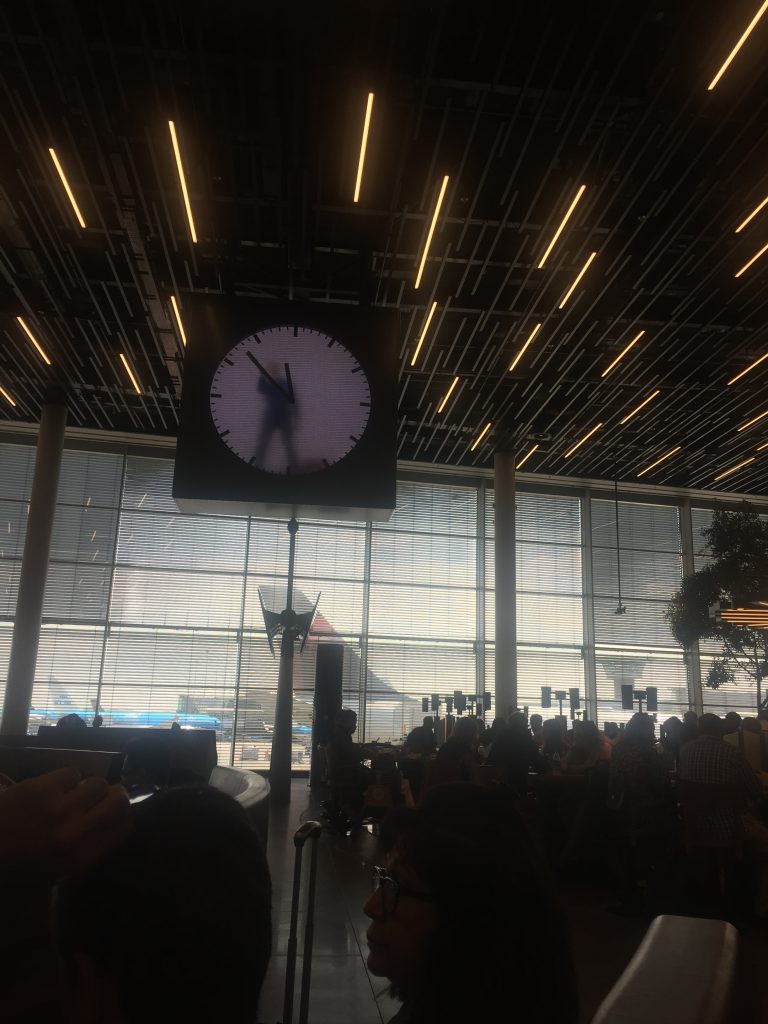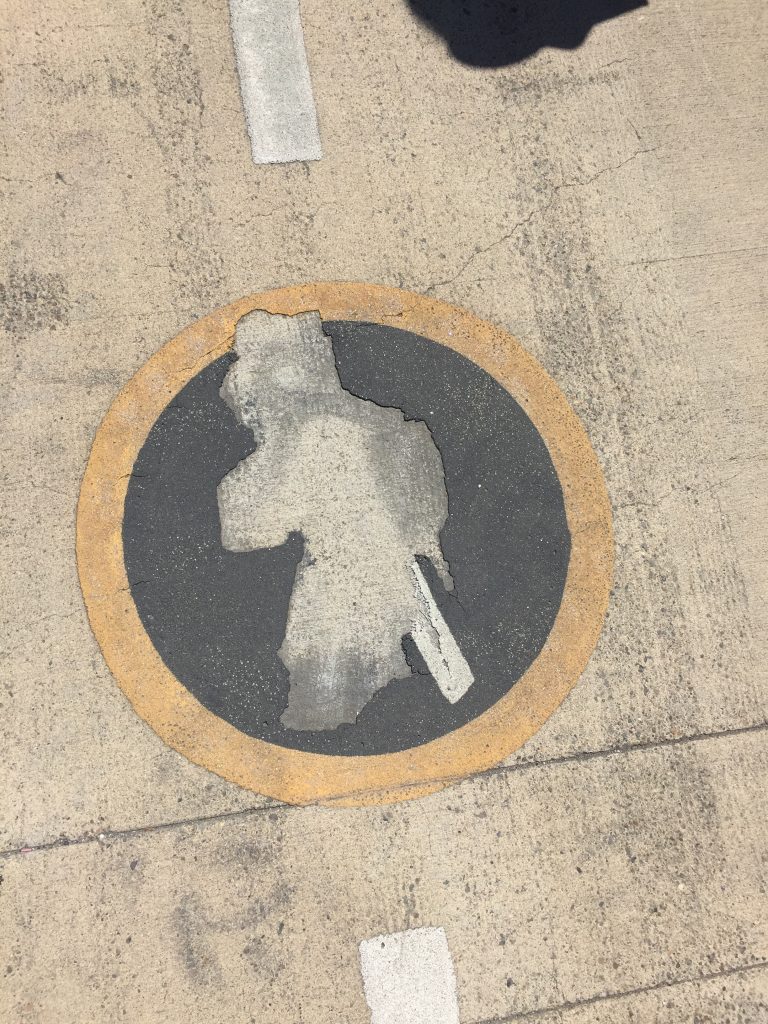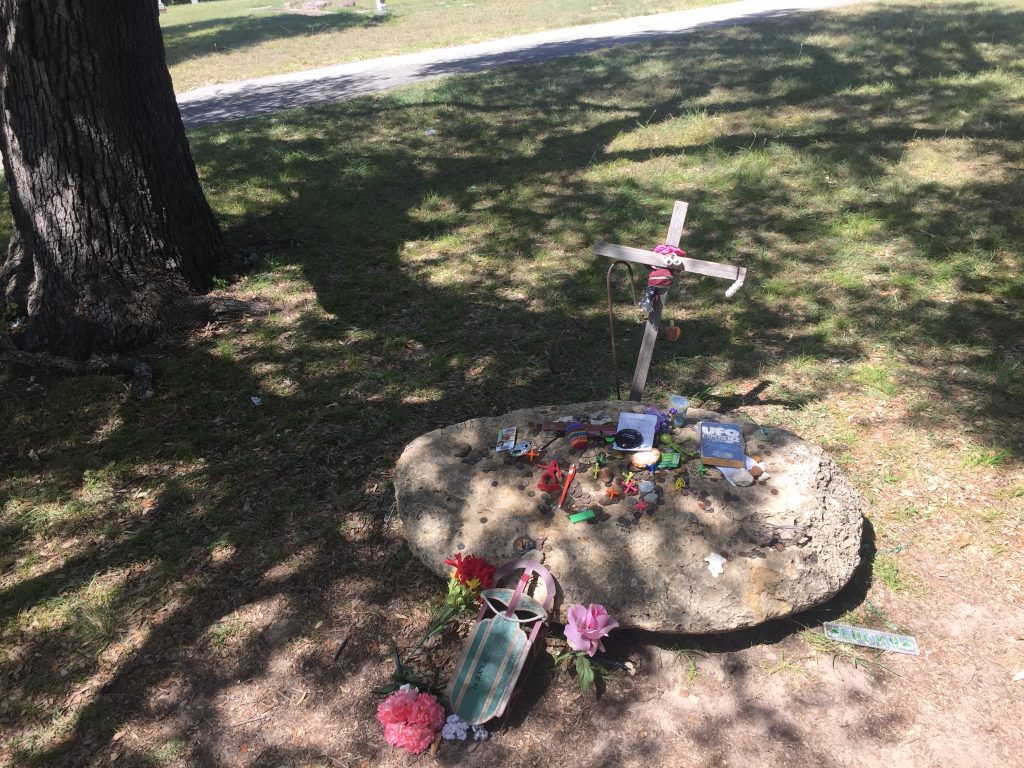
In my absolute willingness to turn over creative guidance to the Editor, I wonder if I may have overestimated her expertise. The relationship between a writer and an editor should involve careful collaboration, I think, or a playful push and pull. It should involve a balance, not necessarily of skills, but of power.
Or so I imagine.
Somewhere along the way I seem to have given up total control to the Editor, assuming, like I do of almost every person I meet, they she knew something about this world that I did not. As I watch her struggle with the crank of an old souvenir penny-crusher, I wonder if I’ve put too much trust in her lead and I worry about the process of reclaiming that power peacefully.
“I don’t think this is the one,” I venture, and she glares at me.
“What makes you the expert?”
“If I wrote the book-” I reason, “-and you assume I did. If I wrote that it would be easy once you found the right machine, it’s not going to be hard.”
She continues to glare and I shrug.
“I never try very hard.”
‘The span known, among exonumists, as the Period for Contemporary Elongateds has already far surpassed the 20-year Period for Modern Elongateds, the distinguishing factor of which was that said elongated exonumia were mainly created and sold as trinkets in stores rather than crushed fresh on-site by the sheer manpower of the tourists themselves. The early timeline of the Elongated Exonumia Tradition is somewhat contested in the field and crushed coins existing prior to the 1960’s are simply called ‘oldies,’ a term that is just as likely to refer to actual, machined designs as it is to nickels left on train tracks.
Suffice to say that the off-centered copper stamping of a smiling gorilla that you’ve frivolously squandered your laundry money on has a long, absurd history and, no doubt, a long, absurd future.
The Period for Contemporary Elongateds is coming to a strange end with the discovery of a mysterious setting available on a series of modern penny-crushing machines in rural Iowa. The most reliable of these machines can be found at the ‘Diesel Dump,’ a small gas-station, laundromat, and dive bar that is popular both with the locals and with a certain brand of roving hipster. By pulling the crank out at its base, as though one is preparing to set the time on their watch, the machine can be operated in reverse and, fed any type of elongated copper, it will produce two quarters and an old penny.
The process has become known, in certain circles, as ‘Maxwell’s Remonetization’ and the machine, ‘Maxwell.’ ‘Maxwell’ and its mysterious process remained a strange but benign attraction until late 2017 when Alexander Horton, a longtime exonumist and recent drug-addict, arrived at the ‘Diesel Dump’ and exchanged his formidable collection of elongated coins for $350 dollars in warm quarters and pennies. The event prompted Valeria Isabella, owner of the ‘Diesel Dump,’ to admit that she hadn’t ever given the machine much thought, neither emptying nor servicing it in the several decades it has gathered dust near the door.
Experts have confirmed that ‘Maxwell’ is returning crushed pennies to their original forms, not just exchanging them for equal value, and that the quarters paid back for the trouble are identical to those used to pay for the initial elongation. The ‘experts,’ it should be said, are all members of a quasi-cult that has formed around ‘Maxwell’s Remonetization’ and believe that the machines capable of the process are acting against the slow decay of our universe. These strangers stalk tourist hubs with heavy pockets and a jangling gait, sure that, in repairing the nation’s flattened coinage, they ward off time’s arrow.
Those in opposition of the ‘Remonetizationist’ movement have criticized its followers for glorifying the past through the worship of old money. The cult leaders have denied these accusations, stating they act only against entropy and are not at all opposed to change.’
‘Maxwell,’ it turns out, has been moved near the counter so that the ‘Remonetizationists’ can be easily monitored. The crank pulls forward with a satisfying thunk and the Editor glares, again, to see that I was right.
From her wallet, the Editor pulls an old souvenir penny, dark with tarnish. She hands it to me without explanation. It says ‘CLOWN TOWN, 1991’ and features a wide, cartoon grin from which several teeth are missing.
“My sister stole my lucky quarter for this,” she says when I hand it back, “And it’s been a pretty shitty thirty years.”
The Editor bends the metal to that it fits into the machine’s input tray and slams it backward. We work the crank together and ‘Maxwell’ groans with mysterious internal effort. After a minute, or so, three coins clatter out the bottom. The Editor retrieves them and she smiles, instantly, in recognition.
“That’s the one.”
The remaining 26 cents is thrown into a pile that eventually pays for two soft-serve ice creams and a coffee on the patio of the ‘Diesel Dump.’ The sun is setting and we haven’t made plans for the night, a prospect that would normally worry me, but seems to be mitigated, in part, by the Editor’s renewed calm. She fingers the quarter incessantly, twirling it on the table and dropping it often enough that I suggest she pocket the thing before it’s lost again. She does, and her hand remains there with it as the ice cream melts to a chocolate puddle on the cheap plastic furniture.
-traveler
‘Though a business model like that of ‘National Harvest’ necessitates many branches, tours are only offered at the founding facility in Northern Vermont. ‘The Stowe Facility’ is a modest structure compared to the modern holdings of ‘National Harvest’ and much of the original machinery inside has been decommissioned, forming a small museum. Active sectors are reserved for research and development as well as a variety of kitschy, public-facing services: a shop where one might purchase a small sack of leaves that once circulated near their childhood home, a booth where one might don the regional uniform and practice firing leaves from a leaf blower (spreading them evenly over the yard of a false home), and, finally, the largest leaf pile in the world where, for a modest five dollars, adults can relive the joy of leaping into the autumnal unknown.
Alisha Hirsch, ‘National Harvest’s’ current CEO, maintains a residence on the grounds of ‘The Stowe Facility,’ though she is rarely seen outside her small, private forest (a sampling of nearly all American deciduous species). A fierce businesswoman, Hirsch garnered a degree of infamy in the 1980’s when she pioneered the use of sticks in otherwise harmless leaf piles with the purpose of dissuading children from inhibiting the re-collecting process. Backlash would later result in the recall of dangerous sticks and the distribution of festively designed ‘jack o’lantern’ leaf sacks, a gesture many still see as self-serving given the ease in which the sacks allow for ‘National Harvest’ to reclaim and process used leaves. Following the haphazard recall, sticks remain in circulation to this day.
Controversies aside, ‘Autumn’ is commonly recognized in the central and northern stretches of the United States and, recently, has begun to enjoy increased popularity overseas as well. Offering rare insight into the complex logistical problems a company such as ‘National Harvest’ might face on a global scale, Hirsch recently outlined a plan for ‘international Autumn.’
‘It couldn’t all happen at the same time,’ she admitted, shuffling through the motely detritus outside her home, ‘The sheer volume of leaves necessary for a worldwide Autumn would be unmanageable. What would need to happen, what we’re testing right now, is a staggered approach, so that the collected leaves from one country are processed and shipped to the next. It would never be Autumn everywhere,’ she concluded, ‘But it would always be Autumn somewhere.’
“Hirsch is a bitch,” the Editor growls, crunching her way across the lawn and toward ‘The Stowe Facility’s’ small giftshop, “It’s not just the sticks- did you know she was behind the child labor shit too?”
“I thought I’d heard something…”
“Back before she was CEO she designed this whole idea of having kids rake up leaves like it’s some sort of great American duty. She convinced a generation of parents to force their kids into slavery and then stabbed them in the back- literally in some cases. There was a lawsuit and everything.”
The Editor stops to collect herself at the giftshop’s door, heaving out a great lungful of air before stepping inside. Her tirade continues but is reduced to a mutter.
“The leaves they’re using these days are designed to break apart after a season or two,” she says, picking up a small plastic bag of leaves and sniffing carefully at the contents, “They realized it’s cheaper to produce lower quality shit because it keeps people from just re-using their own, storing them in the basement or whatever. Used to be you could jump in the same pile ten times before it flattened out…” She chooses another sack and grimaces at the smell. “What order are these in?”
I spend time looking over a few decorative magnets while the Editor describes her old town to a clerk. My own childhood home was situated in a pine forest and, while there were a few families who celebrated ‘Autumn’ with a transplanted maple or two in their yard, it’s not a season I became accustomed to until I began to travel.
“Found it!” the Editor smiles, her mixed feelings about ‘National Harvest’ briefly suppressed by a wave of nostalgia, “Take a whiff of this and tell me what you think?”
The leaves in the Editor’s bag smell much like the others- much like the store and the grounds overall, but I smile back and give her an appreciative thumbs up.
“It’s expensive,” she admits, crinkling the little sack between her fingers, “They’re not producing this mixture anymore. And these are… old. Like, they could have been from my neighborhood when I was a kid there.”
“At least they’d be durable.”
“Yeah…”
I see the Editor struggling to justify the expense and, in the end, agree to split the cost with her.
“It’ll be nice to smell something besides our feet when we camp.”
The Editor is subdued again as we prepare for the next stretch of highway. She sniffs at the bag before carefully zipping it into her pack.
“It’s weird to think that the others, the other like me- they’d walk away with a completely different bag. Their ‘Autumn’ would be totally different. Maybe it died with them.”
“Maybe,” I admit, “But if we’re off to meet one of them, maybe we’ll get a chance to compare.”
The Editor disappears into her helmet before I can gauge any reaction, but I see her carefully crush several leaves under her boot before mounting the bike and she laughs as I steer us through a loose pile in the parking lot, scattering it behind us in a great, broken cloud.
-traveler
‘Blame for ‘The Sharp Place’ lies definitively with the Baby Boomers, whose method for the disposal of razors parallels their method for handling the climate, a whimsical laissez-faire approach (that may, yet, be the death of us). The method is simple, if not baffling: 1. A slot is cut into the bathroom wall, sometimes in the mirror cabinet and sometimes garishly chiseled out of tile. 2. Used razors are pressed into the slot by freshly shaven homeowners. 3. Intrusive ideas about where the razors may go or what may happen when they are found are ignored. 4. The homeowner’s subconscious remains distantly aware that the walls are filling with rusted razors, hair, and blood. 5. The homeowner’s subconscious manifests irrational fears that the razors will turn up at inconvenient times (i.e. in the apples given to children at Halloween). 6. Repeat.
‘The Sharp Place,’ then, is an American state of mind, a chicken-or-egg straining of logic that takes the example of pressing razors into the walls of our private restrooms and allows us to assume the worst of everyone in the neighborhood because, if good people can press razors into their walls, who knows what the shifty couple across the street might be capable of? Gluing them to playground equipment? And if the neighbors are feeding razorblades to stray dogs, is it really so bad to press them into the bathroom wall where, at least as far as we can tell, they are safely away from children and animals?
‘The Sharp Place’ is equal parts condemnation and permission, the new American paranoia. It’s the reason razors are banned from airplanes- if we can’t trust ourselves with them, we certainly can’t trust the man sitting next to us who may, in our absence, slip under the seat and run one across our delicate Achilles tendon. And he, under the seat, can hardly trust that we have not gone to press razors into the walls of the airplane bathroom, risking catastrophic depressurization for the relief of being free of a blade.
‘The Sharp Place’ is also a place, deep underground but open to public viewing. It is the terminus of a complex series of pipes, an infrastructure that connects the walls of all American bathrooms and ferries abandoned razors into a natural pit, the bottom of which remains something of a mystery. It is a place that smells like blood, though it is likely only rust.
Visiting the site of ‘The Sharp Place’ does nothing to mitigate the feeling of it, though some have found small relief in bringing boxes of their used razors for disposal at the hub- a guilty pilgrimage that misses the point entirely.’
The Editor and I search for an entrance to ‘The Sharp Place’ off I-5 in Washington and find nothing but an orchard where Shitholes suggests it might be. I call her superstitious when she stops me from eating an apple there but I drop it when she isn’t looking. Better safe than sorry, I suppose.
-traveler
‘For a country with such capitalist ideals, there is nothing more damaging to the American ego than the common ‘For Sale’ sign. It appears in a city as the first blister of a pox, reddening windows and hopping from the threshold of one business to the next. Storefronts collapse like rotten teeth, leaving ugly gaps in the once-smile of Main Street. In these trying times it’s easy to wonder who passed this wasting disease to us- which of the world’s sick economies has coughed in our direction most recently?
Rest assured, reader: our affliction is auto-immune. In America, everything is, and always has been, for sale.’
The Editor is heartbroken to find an empty storefront where ‘Zeitgeist Publishing’ once held a branch. She refuses to admit it but, in terms of heartbreak, there’s no more obvious tell than hiding one’s face.
We’ve both seen the signs, or, I’ve seen the signs and I suspect she has too (I’ve been told I read to closely into silences). Neither ‘The Waterhole Death Sequence’ nor ‘Speculation’ boded well for the Editor’s town and it’s not often a path veers so far off course that it’s entirely unpredictable. I try to tell her as much (I’ve been told I offer solutions when I should be offering condolences).
“Do you know the difference between a path and a trail?” she asks, drawing an ‘X’ across the dusty pane of glass.
I chew the inside of my cheek and narrow my eyes: “No.”
“When you’re on a trail, you’re following something. When you’re on a path, you’re just walking.”
“How long do you think we’ve been on a trail?”
“Maybe this whole time.”
-traveler
The Editor’s home is only a few hours away when we drive through ‘Retro-Speculation,’ a façade that stands, like a headstone, where a real town once stood. Each building is constructed with two faces and the installation is set up in such a way that Main Street southbound appears as Speculation once was and Main Street heading north is Speculation in ruins. The Editor prepares me for as much but I still nearly run us off the road, distracted by the ghost town in the side mirror. She jabs my ribs in warning and I park in order to safely satisfy my curiosity.
‘‘Retro-Speculation’ does as much to encourage nostalgia as it does to criticize it, the ultimate interpretation of the project heavily dependent upon which direction a traveler is driving: toward the city that drained Speculation of life, or away from it. On one hand, the mirrored Speculation sits heavily on the conscience of those entering the city and becomes a blatant condemnation for those exiting the same way. On the other, it is easy to suggest that ‘Retro-Speculation’ was constructed purely as a timeline- a visual reminder of the city’s history (a preface and epilogue written on the same page).
The grant that once provided for the upkeep of ‘Retro-Speculation’ has recently been dissolved and both sides now fall into disrepair. Renewed interpretation relies heavily on the viewer’s belief in a universal sort of irony and their comfort with impermanence in its broadest application.’
There’s not much to see in ‘Retro-Speculation’ that can’t be taken in from the bike. It’s not a place made for stopping, though graffiti suggests we’re far from the first to lean through the empty windows and test the doorknobs. We take pictures standing at angles that aren’t meant to be viewed- the post office decaying on the right and simply weather-worn on the left. The Editor tells me the story of how she once lost her parents in the real Speculation and how, in the tear-filled interim, they didn’t even realize she was gone. She tells me Speculation set the standard for Halloween. We share a bag of chips in the field behind the façade, ignoring the exposed wooden supports. We gather ourselves before dark and put the grim town firmly behind us.
The Editor hopes Zeitgeist will have answers for her and I hope sympathetically, swallowing my doubts, aware that they will sit in my body like gum.
-traveler
Rear View Mirror
- December 2025
- November 2025
- October 2025
- September 2025
- August 2025
- July 2025
- June 2025
- May 2025
- April 2025
- March 2025
- February 2025
- January 2025
- December 2024
- November 2024
- October 2024
- September 2024
- August 2024
- July 2024
- June 2024
- May 2024
- April 2024
- March 2024
- February 2024
- January 2024
- December 2023
- November 2023
- October 2023
- September 2023
- August 2023
- July 2023
- June 2023
- May 2023
- April 2023
- March 2023
- February 2023
- January 2023
- December 2022
- November 2022
- October 2022
- September 2022
- August 2022
- July 2022
- June 2022
- May 2022
- April 2022
- March 2022
- February 2022
- January 2022
- December 2021
- November 2021
- October 2021
- September 2021
- August 2021
- July 2021
- June 2021
- May 2021
- April 2021
- March 2021
- February 2021
- January 2021
- December 2020
- November 2020
- October 2020
- September 2020
- August 2020
- July 2020
- June 2020
- May 2020
- April 2020
- March 2020
- February 2020
- January 2020
- December 2019
- November 2019
- October 2019
- September 2019
- August 2019
- July 2019
- June 2019
- May 2019
- April 2019
- March 2019
- February 2019
- January 2019
- December 2018
- November 2018
- October 2018
- September 2018
- August 2018
- July 2018
- June 2018
- May 2018
- April 2018
- March 2018
- February 2018
- January 2018
- December 2017
- November 2017
- October 2017
- September 2017
- August 2017
- July 2017
- June 2017
- May 2017
- April 2017
- March 2017
- February 2017
- January 2017
- December 2016
- November 2016
- October 2016
- September 2016
- August 2016




